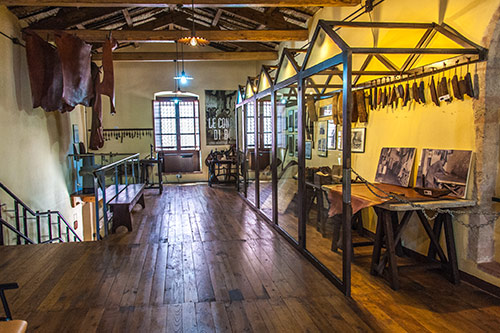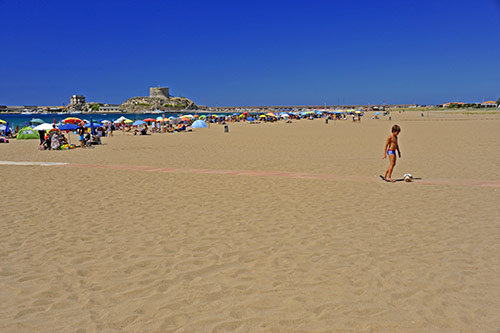Bosa and surroundings
map of Bosa and its surroundings with the marked sights
Bosa
 The small town is beautifully nestled between the surrounding mountains.
The small town is beautifully nestled between the surrounding mountains.
The Temo River has carved its estuary here and flows into the sea a few kilometers below Bosa. Bosa is the only town in Sardinia that was built directly on a river.
Vineyards adorn the slopes of the surrounding area, and due to the local abundance of water, agriculture thrives here.
The area has been inhabited since the time of the Nuraghians. Later, Phoenicians and Romans settled here.
The present-day town began to grow with the construction of the Genoese fortress.
This 12th-century fortress still stands as a ruin atop Bosa’s hill.
 The picturesque historic center of Bosa is unique and, compared to other cities like Alghero or Sassari, still relatively tranquil.
The picturesque historic center of Bosa is unique and, compared to other cities like Alghero or Sassari, still relatively tranquil.
The shady and often very narrow lanes invite leisurely walks even during the hot season.
The main street of the old town is Corso Vittorio Emanuele, which still retains its historic granite paving. Tall old palaces line the sides, some with magnificent facades adorned with iron balconies.
At the end of Corso stands the Cattedrale dell’Immacolata, built in the 16th century and reconstructed in the 19th century.
This blend of Baroque and Neoclassical styles is evident both in its exterior and interior, which is adorned with splendid ceiling paintings, altars, and carvings.
 The Temo River defines the scenery at the edge of the centro storico.
The Temo River defines the scenery at the edge of the centro storico.
Such a riverside promenade is unparalleled on Sardinia.
A palm-lined avenue runs along the river, where blue fishing boats are moored.
Without the presence of cars, one might feel transported several hundred years into the past.
The Temo is the only river on the island that is navigable for at least a few kilometers.
The ancient stone bridge “Ponte Vecchio” spans the river, which was long the sole connection between the two banks.
Excursion boats offer tours below the bridge, along the old town, and upstream to the church of San Pietro.

On the opposite bank, directly across from the palm promenade, stand the buildings of an old tannery.
Due to the abundant water available year-round, Bosa became a center for Sardinian leather and fur processing.
Hides and leather were once significant export items.
During World War II, there was a final surge in activity. The tanneries of Bosa were among the few that met the military’s quality standards.
However, traditional tanning craftsmanship could not keep pace with industrialization and competition from the Far East starting in the 1960s.
Consequently, the last remaining company had to close.
Several years ago, restoration efforts began on the remaining buildings to preserve them from impending decay. Today, they house restaurants, a museum, and residential apartments.
Museo delle Conce (Tannery Museum)

The small museum is located in one of the former buildings of the tannery along the riverbank. The entrance is on the side opposite to the Temo.
The ground floor features a significant portion of glass flooring, allowing visitors to observe the tanning pits embedded in the ground below.
Along the walls, several historical leatherworking machines are still displayed.
On the upper floor, showcases exhibit tools for cleaning hides and other work equipment.
Leather goods and saddlery from Bosa were highly sought after in many countries due to their exceptional quality, contributing to the relative prosperity of the city.
Museum “Casa Deriu”

In house number 59 on Corso Vittorio Emanuele, another noteworthy museum can be found.
This three-story building dates back to the 19th century and has been largely preserved in its original state.
It serves as a fine example of the old luxurious townhouses of Bosa.
On the second floor, visitors can explore the living room, bedroom, dressing room, and dining room of a family.
The piano from Germany, floor tiles from Florence, wall paintings, and expensive furniture all testify to the wealth of the city and its residents during that era.
The other two floors house exhibitions featuring artists from Bosa.
Included in the ticket price is a guided tour available in Italian or English.
Castello Malaspina

For those who are good on foot, the castle complex can be reached from the old town via numerous stairs and alleys.
The city climbs up the hillside almost to the fortress wall.
As you ascend, the houses become simpler. While the wealthy citizens lived down by the river, the common people had to settle on the steep slopes of Serravalle.
Construction of the fortress began in 1112. When the castle was completed in the 13th century, the local population began to settle within the protection of the fortress, giving rise to present-day Bosa.
The castle courtyard is surrounded by a high wall reinforced with several towers. The northern tower was rebuilt in the 14th century by Giovanni Capula, who also constructed the Torre di San Pancrazio and the Torre dell’Elefante in Cagliari.

During the restoration work, the deteriorated battlements were partially rebuilt, allowing visitors to almost entirely circumnavigate the fortress along the wall.
From above, magnificent views of the old town of Bosa and the Temo River extending to the sea at Bosa Marina unfold repeatedly.
Upstream, the gaze stretches into the fertile valley, with the church of San Pietro visible from this vantage point.
In the castle chapel “Regnos Altos,” a well-preserved cycle of frescoes dating back to around 1345 was discovered during restoration work in 1972.
Around 1410, the Spaniards conquered Bosa along with the Castello. They transformed the castle into a military garrison, reinforced the fortifications, and built new towers.
San Pietro Extramuros

The church is situated in the valley of the Temo, approximately 2 km upstream from the Ponte Vecchio. (see map)
Its name, “extramuros,” derives from its location outside the medieval city walls of Bosa.
Originally, the area surrounding the church was the site of ancient Bosa (Bosa Vetus). It wasn’t until the completion of the Castello Malaspina that the present-day city began to develop.
The construction occurred in three phases, commencing in 1062 after the city became the seat of a diocese in 1060. Initially built in the Romanesque-Lombard style, various additions and Gothic elements were incorporated in later stages of construction.
The interior is kept very plain. Above the holy water font hangs a plaque with a Latin inscription dedicated to the consecration in 1073.
While the church is constructed of red trachyte, a limestone architrave adorned with images of saints is placed above the entrance.
Bosa Marina

The small seaside resort is just under 3 km from the city center.
The beach is over 150 m wide, very clean, and consists of fine, brown sand. It encloses an 800 m long bay that extends to Isola Rossa.
The small rocky island is connected to the mainland via a pier, and atop it stands a Spanish Saracen tower.
Below the tower, there are a few boat moorings, and some old World War II bunker installations are still present on the rocks.
Due to its proximity to the old town, visitors can easily combine a city tour with a day at the beach during a trip to Bosa.
Thanks to its unique location, the beach is well-protected from waves even on windy days, making it especially suitable for families with small children.
